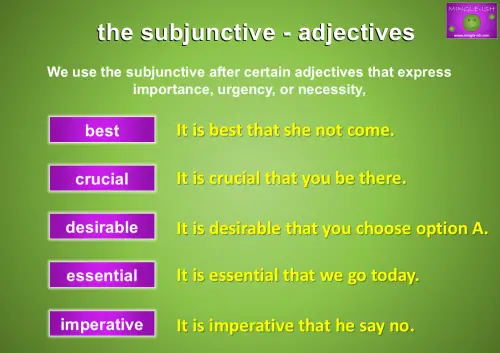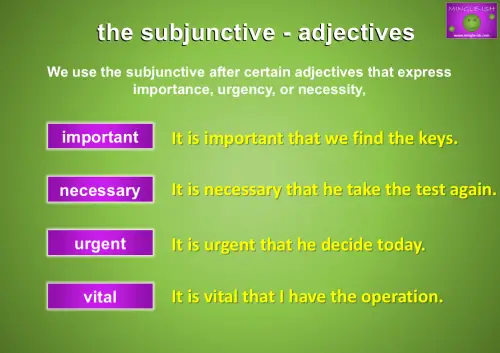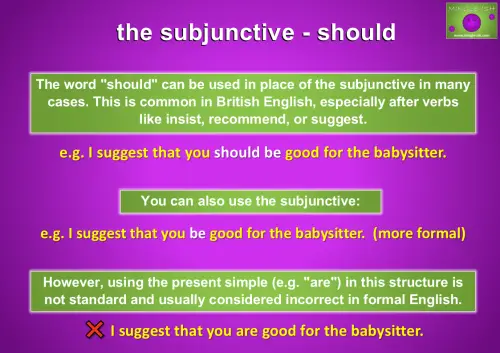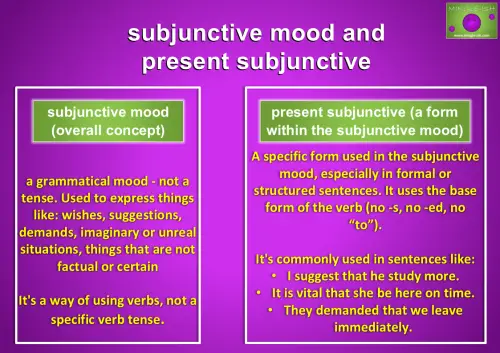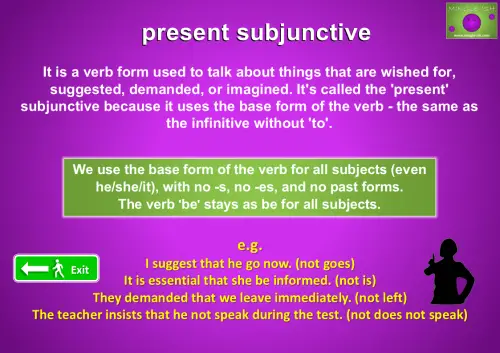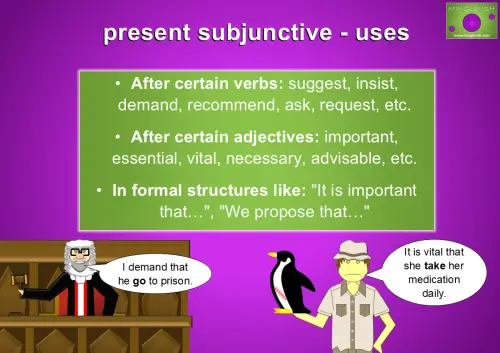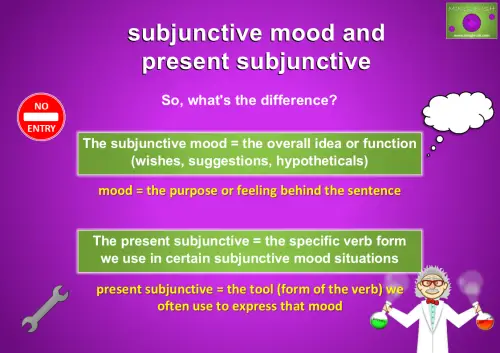The subjunctive mood can seem confusing at first, but don’t worry – it’s easier than it sounds! We use it to talk about wishes, suggestions, and things that aren’t real. It’s not about when something happens, but about the mood or attitude behind the sentence.
This page will show you how it works, when to use it, and help you feel more confident using it in everyday English.
What is the subjunctive mood?
The subjunctive mood is a special way of using verbs to talk about things that are not certain or real. Unlike verb tenses, which tell us when something happens (past, present, future), the subjunctive shows the mood or feeling behind a sentence.
We often use the subjunctive when we want to express wishes, give suggestions, talk about imaginary situations, or show something that’s not a fact. It’s a little different from normal verb forms because it sometimes uses the base form of the verb, even when the subject is singular or plural.
While the subjunctive isn’t used in every sentence, knowing when and how to use it can help you sound more natural and fluent in English.
When do we use the subjunctive?
The subjunctive isn’t used all the time, but it pops up in some very specific situations. You’ll hear it when people talk about things that aren’t real, like wishes or imaginary situations, or when giving strong advice or suggestions. It’s also used in a few formal or fixed phrases. Let’s look at the main times you’ll need to use the subjunctive in English.
after verbs
It’s used after certain verbs that express things like wishes, suggestions, demands, or recommendations.
For example:
- to advise (that)
e.g. I advise that she come early.
subjunctive: come (instead of comes) – base verb used after “advise that” - to ask (that)
e.g. We ask that everyone bring a towel.
subjunctive: bring - to command (that)
e.g. I command that you listen to me.
subjunctive: listen (base verb, even though it sounds normal, it stays unchanged) - to demand (that)
e.g. Mum demands that I be on time.
subjunctive: be (instead of am) - to desire (that)
e.g. It is desired that all participants arrive early.
subjunctive: arrive - to insist (that)
e.g. We insist that she not walk home alone.
subjunctive: not walk (notice how “do/does” isn’t used – the base verb follows that) - to propose (that)
e.g. We propose that they be cared for.
subjunctive: be (used instead of are) - to recommend (that)
e.g. Everyone recommends that she finish with him.
subjunctive: finish (base verb used after recommends that) - to request (that)
e.g. My boss requests that I work until 7.
subjunctive: work - to suggest (that)
e.g. The teacher suggests that he study more.
subjunctive: study (not studies) - to urge (that)
e.g. I urge that she reconsider.
subjunctive: reconsider (base verb used directly)
The word “that” is used after certain verbs to introduce a subordinate clause — basically, it connects the main part of the sentence to what is being suggested, demanded, or wished for.
Here’s why it’s used:
- It introduces the idea being expressed
I suggest that she go home.→ that she go home is the part being suggested. “That” shows what the suggestion is. - It marks the start of the clause where the subjunctive applies.
- It helps signal that the clause coming next is not a statement of fact, but a request, wish, or demand — something not yet real or hypothetical.
Do we always need “that”? Not always. In spoken English, people often leave it out:
- ✔ I suggest she go home. (also correct) But in formal or written English, using that is clearer and more common:
- ✔ I suggest that she go home.
So, the purpose of that is to introduce the clause that follows certain verbs — and to clearly show the connection between the main verb and the idea being expressed, especially when the subjunctive is involved.
with adjectives
We use the subjunctive after certain adjectives that express importance, urgency, or necessity, especially when those adjectives are followed by a clause starting with “that.” The clause after the adjective expresses something not real yet — a wish, a possibility, a recommendation — so we use the base form of the verb (the subjunctive), even for he/she/it.
Here’s some example sentences using subjunctive mood with the adjectives:
- best
e.g. It is best that she not come. - crucial
e.g. It is crucial that you be there. - desirable
e.g. It is desirable that you choose option A. - essential
e.g. It is essential that we go today. - imperative
e.g. It is imperative that he say no. - important
e.g. It is important that we find the keys. - necessary
e.g. It is necessary that he take the test again. - urgent
e.g. It is urgent that he decide today. - vital
e.g. It is vital that I have the operation.
the subjunctive with ‘should’
The word “should” can be used in place of the subjunctive in many cases. This is common in British English, especially after verbs like insist, recommend, or suggest.
e.g. I suggest that you should be good for the babysitter.
You can also use the subjunctive:
e.g. I suggest that you be good for the babysitter. (more formal)
However, using the present simple (e.g. “are”) in this structure is not standard and usually considered incorrect in formal English:
❌ I suggest that you are good for the babysitter.
✅ Better: I suggest that you be good… or I suggest that you should be good…
subjunctive mood and the present subjunctive
Subjunctive Mood (overall concept)
The subjunctive mood is a grammatical mood — not a tense — used to express things like:
- wishes
- suggestions
- demands
- imaginary or unreal situations
- things that are not factual or certain
It’s a way of using verbs, not a specific verb tense.
Present Subjunctive (a form within the subjunctive mood)
The present subjunctive is a specific form used in the subjunctive mood, especially in formal or structured sentences. It uses the base form of the verb (no -s, no -ed, no “to”).
It’s commonly used in sentences like:
- I suggest that he study more.
- It is vital that she be here on time.
- They demanded that we leave immediately.
So, what’s the difference?
The subjunctive mood = the overall idea or function (wishes, suggestions, hypotheticals)
The present subjunctive = the specific verb form we use in certain subjunctive mood situations
Think of it like this:
Mood = the purpose or feeling behind the sentence
Present subjunctive = the tool (form of the verb) we often use to express that mood
the present subjunctive
The present subjunctive in English is a verb form used to talk about things that are wished for, suggested, demanded, or imagined — things that are not necessarily real or happening now. It’s called “present” not because it’s about the present time, but because it uses the base form of the verb (same as the infinitive without “to”).
Forming the present subjunctive
We use the base form of the verb for all subjects (even he/she/it), with no -s, no -es, and no past forms. The verb “be” stays as be for all subjects.
For example:
- I suggest that he go now. (not goes)
- It is essential that she be informed. (not is)
- They demanded that we leave immediately. (not left)
- The teacher insists that he not speak during the test. (not does not speak)
Where is it used?
After certain verbs: suggest, insist, demand, recommend, ask, request, etc.
After certain adjectives: important, essential, vital, necessary, advisable, etc.
In formal structures like: “It is important that…”, “We propose that…”
difference between the subjunctive mood and the present subjunctive
The subjunctive mood is the overall mood or tone we use in English to talk about things that aren’t real – like wishes, dreams, imaginary situations, or things someone demands or suggests. It’s not about facts, but about what could, should, or might be.
The present subjunctive is the form of the verb we often use to express that mood. It usually looks like the base form of the verb (the infinitive without “to”), even with he/she/it.
For example:
I suggest that he go to bed early.
Here, “go” is in the present subjunctive form, helping us show the subjunctive mood.
So, in short:
The subjunctive mood is the feeling or function (imagining, wishing, suggesting), and the present subjunctive is the grammar tool (the verb form) we use to express it.
the past subjunctive
There is a past subjunctive in English, but it’s very limited and mostly shows up with just one verb: “be.” Here’s what you need to know.
The past subjunctive looks like the simple past, but it’s used to talk about unreal, imaginary, or hypothetical situations — things that are not true, not real, or contrary to fact.
key rule
Use “were” instead of “was” for all subjects. Even with I/he/she/it, we use “were” to show that the situation is hypothetical or unreal.
For example:
- If I were rich, I’d buy a castle.
- She acts as if she were the boss.
- I wish it were summer all year round.
- He talks like he were in charge.
In all of these, “were” shows the situation is not real — it’s a wish, a dream, or just imaginary.
real situation – I was tired yesterday.
subjunctive (unreal) – If I were tired, I’d rest.
real situation – She was here earlier.
subjunctive (unreal) – I wish she were here now.
Subjunctive Mood Quizzes
Ready to put your grammar skills to the test? Try these quick quizzes on the subjunctive mood and see how much you’ve learnt! You can test yourself with more quizzes by visiting my channel – https://www.youtube.com/@mingle-ish
explore more grammar guides and boost your English skills
Now that you’ve got the hang of the subjunctive mood, why not explore some of our other grammar guides? From tricky tenses to confusing conditionals, we’ve got loads of useful tips to help you sound more natural and confident in English. Check out the rest of the site and keep learning!




